Gulf Of Guinea
-
- Challenging the Myths of Pirate Violence Maritime Reporter, Aug 2014 #24
“In the last five years, pirates have killed at least 411 fishermen and wounded at least 1,000 more, suggested Mujibur Rahman, Chairman of Cox’s Bazar District Fishing Trawler Owners Association (DFTOA). According to the DFTOA, pirates attacked more than 1,000 fishing boats, abducting more than 3,000 fishermen, killed over 45 and collected more than $1.28 million in ransoms from fishery owners of two coastal towns – Chakaria and Maheshkhali, alone from late 2011 to late 2012,” reported a Bangladeshi paper in April 2013. If true then this staggering level of violence eclipses that of any other reports of actual or alleged pirate violence – be it in Africa or South East Asia. Like most forms of maritime “piracy” (which often technically do not even qualify as piracy under the UNCLOS definition) Bangladeshi piracy is an acknowledged local phenomenon that primarily affects locals and local or regional economic interests. International media and watchdogs often only sit up and pay attention when international shipping is affected. Hence, whenever a region grabs the headlines for pirate attacks, we read bizarre news about “the world’s most violent pirates”, but only when their attacks cause casualties amongst the crews of internationally-trading vessels. Some of this has a whiff of fear-mongering about it and generally leaves seafarers confused and frightened about the nature of the piracy threats in the various parts of the world. This is not to say that those casualties reported are not a cause for concern, but what appears to be lacking is a discussion informed by the most basic analysis of the facts. For starters, violence levels in piracy worldwide would appear to be much higher than what is commonly circulated. Like the piracy phenomenon itself, violence is underreported when incidents do not meet certain legal criteria or definitions of piracy. This is legally correct, but it is misleading when assessing the potential for violence (and thus planning appropriate risk mitigation) since the local perpetrators are often the same who commit crimes against local shipping or at least they hail from similar backgrounds. This is true for Somalia, where many of the original pirates were involved in criminal activity against Somali and Yemeni fishing vessels. It is also true for the Gulf of Guinea, where the same Niger Delta youths who prey on inshore traffic and kidnap oil workers are also hired by organised criminals to hijack tankers. Finally, in South East Asia, local criminals (including active or former military personnel) form the operational nucleus for many of the maritime scams including tug-jacking and product theft.
South and South-East Asia Piracy
The local nature of piracy in Asia, as described above, makes it less newsworthy for the international community. When international shipping (though often in a regional context) is affected, like tanker hijackings, then it frequently involves a strong collusive element involving government security forces, hijackers and owners that does not encourage reporting. However, isolated reporting like the one on Bangladeshi fishermen, or the killing of seven Thai seamen off Songkhla port in October 2013, or the slaying of nine Filipino seafarers in the southern Philippines in December 2013 (with some of the victims being beheaded), suggests a particularly ruthless streak amongst some of Asia’s pirates that has no equivalent in Africa. Historically, many of South East Asia`s ghost ship’s original crews in the 1990s were also disposed of by the hijackers – many disappeared without a trace.
Gulf of Guinea Piracy
It has become fashionable to brand the pirates of the Gulf of Guinea as particularly violent. This perception is largely based on anecdotal reports that date back to the 1970s, where European crews faced down pirates on the decks of their ships. It was later reinforced through the rise of the Niger Delta youth militias, who espoused violence as the only means to address their grievances. The level of aggression amongst those youths is felt to be intimidating even by the Niger Delta population, as a number of studies on the Niger Delta Youths have shown. Hence it is not a “natural” Nigerian, let alone West African, trait. Some of this militant attitude carried over to commercially-driven piracy, although the focus of violent groups in the Niger Delta remains on domestic issues, with most of the brutality being reserved for gang fights and disposal of political opponents.
In order to make Nigerian piracy comparable to that in other regions, the focus has to be on the post-insurgency period commencing in October 2009 to eliminate insurgency-related effects.
Between that date and June 2014 Risk Intelligence has documented 738 attacks in West Africa – of which consistently between 80-100 incidents per year occurred in the Gulf of Guinea. Twenty of those incidents involved fatalities – all in or near Nigerian waters. Seven of those 20 incidents involved government security forces. Of the 37 fatalities recorded in that period, 15 were security personnel.
Of the remaining 22, 12 were killed in incidents on inshore waterways. The remaining ten were on offshore vessels, fishing vessels and foreign merchant vessels. Four killings took place in cold blood – two of them on foreign vessels.
More generally, African pirate violence comes across as casual violence, lack of restraint or, especially in the Gulf of Guinea, poor weapons discipline. A study by Risk Intelligence of 93 tanker hijackings in the Gulf of Guinea between 2010 and 2013 showed that the number of weapons discharges had increased, but had not caused a rise in casualties. Crew testimonies suggest that both in East and West Africa drug and alcohol abuse play a major role in attacker violence and erratic behaviour. As the above figures for the Gulf of Guinea show, most casualties have involved security forces, and inshore incidents - not attacks on transiting foreign-flagged vessels. Gulf of Guinea pirates are well armed, and often intimidating, but in terms of fatal attacks there is no reason for them to be singled out over pirates elsewhere.
In the case of Gulf of Guinea – or specifically Nigerian – pirates, there is the mantra that they will attack even when there is an embarked government security force team. This explanation exhibits a fundamental misunderstanding of the nature of Nigerian pirates. They attack, and kill, because they are facing government security forces. The reason is that the pirates are the same youths who face both oppression and extortion by corrupt security forces in the Niger Delta. This combative attitude in the face of armed opposition is largely unique to Nigeria (or Nigerian pirates with a Niger Delta background) and not reflective of general pirate behaviour in West Africa. It also suggests that embarking government security forces may not be as effective in reducing the risks to crews as the embarkation of PCASP has been in the Indian Ocean.
Conclusion
Whatever the actual numbers of Bangladeshi fishermen killed, it is a good example of a specific local situation with unique drivers that are often overlooked by analyses on pirate violence which focus on numbers and trends only in the context of international shipping. The local context provides explanations as to when and where – and against whom – violence can be expected and also as to the true potential for violence in any given region of the world.
Pirate violence is an emotionally charged subject. Better understanding hinges on more accurate and comprehensive reporting and informed analysis. It also requires a common understanding of what constitutes “violence”. Fear-mongering and perpetuation of unfounded myths are unhelpful in alleviating anxieties amongst seafarers and in preparing them for dealing with the problem.
Security companies and specialized media in particular have a responsibility to not stoke the flames for fear of losing relevance. Often as not, good security advice constitutes what enables clients to make sound commercial decisions and protect their crews more effectively when based on the most objective facts available.
The Author
Dirk Steffen is the Director Maritime Security for Risk Intelligence. He has been covering the Gulf of Guinea as a maritime security consultant and analyst since 2004.
e: [email protected]
w: www.riskintelligence.eu
t: +45 70 266330
(As published in the August 2014 edition of Maritime Reporter & Engineering News - http://magazines.marinelink.com/Magazines/MaritimeReporter)
-
- Product Tanker Hijackings Maritime Reporter, Nov 2013 #72
Understanding Trends & Tendencies in the Gulf of Guinea Gulf of Guinea piracy presents a radically different picture compared with Somali piracy. Since decades it has been a kaleidoscopic mix of short duration hijackings, militant disruptions, kidnappings, robberies and thefts, depending on the location
-
- Piracy Offshore Africa: Securing a Continent Maritime Logistics Professional, Q2 2014 #22
, both onshore and offshore. The summit coincided with reports of renewed piracy activity in the Gulf of Aden; ongoing attacks on shipping in the Gulf of Guinea, and explosions and mass arrests in Kenya, all serving to underline the scale of that challenge. High Stakes: International Interests and Effort With
-
- The Changing Face of Piracy Maritime Logistics Professional, Q1 2014 #24
risks: piracy. While piracy has been a concern in the maritime industry for centuries, a new hotspot has emerged off the coast of West Africa in the Gulf of Guinea. Specifically the industry is concerned about attacks occurring in the territorial waters of Benin, Nigeria, Togo and the Ivory Coast. Over the
-
- Maritime Crime Continues at Pace Maritime Logistics Professional, Q4 2014 #20
on the agenda for organized criminal gangs. We can expect to see a continuation in incidents of boarding and cargo theft in Southeast Asia and in the Gulf of Guinea as criminal groups continue to prey upon the vulnerable and the unprepared.” The Gulf of Guinea has seen 15 confirmed criminal incidents, compared
-
- The Riskiest Places to do Business – and Why Maritime Logistics Professional, Q1 2013 #44
there is every possibility that piracy could see resurgence in yet another vacuum. Without a doubt, the situation today is fragile and reversible. Gulf of Guinea The Gulf of Guinea (GoG) has seen resurgence of piracy incidents in 2012 as piracy, or alternatively robbery at sea, has shifted around the region
-
- An Unarmed Approach to Piracy Maritime Logistics Professional, Q3 2013 #14
military support. Modern piracy is here to stay. And it’s no longer confined to the Gulf of Aden. The latest hotspot is West Africa, where the oil-rich Gulf of Guinea is seeing a spike in the number of attacks. Vulnerable areas include the waters off Nigeria, Ivory Coast, Ghana, Benin, Togo, Cameroon and Lagos
-
- Aluminum Boats Delivers 85-Foot Crewboat— Sixth Built For Land And Marine Maritime Reporter, Jan 1991 #42
radar, a Kelvin Hughes Husun VHF radio, an ICOM SSB radio, and a Marconi depth recorder. The Vessel is Bureau Veritas (BV) certified, Sea and Rivers, Gulf of Guinea. Aluminum Boats, Inc. is part of the Trinity Marine Group, Gulfport, Miss., which is owned by Trinity Industries, Inc., Dallas, Texas
-
- 24/7 Voyage Security Risk Assessment … at the click of a mouse Maritime Reporter, Mar 2020 #62
Reports are another of the services the company provides: two recent examples include a survey of maritime security incidents in West Africa, ‘Gulf of Guinea 2007-2018’; and several publications assessing the ever-changing security situation in the Persian Gulf and Iran, including a decision brief produced
-
- Maritime Security: Failing to Prepare is Preparing to Fail Marine News, Jun 2020 #14
force, it opens opportunity for attack. This is why it is more prevalent for commercial and pleasure craft vessels transiting global hot spots like the Gulf of Guinea off the coast of West Africa, or Gulf of Aden (Yemen) to have armed guards, or additional enhanced security measures.COVID-19 caused unemployment
-
- Reflections on the Trends That Have Shaped the Maritime Industry Maritime Reporter, May 2021 #14
incidents in New York, Pennsylvania, and Washington, DC. Later, the hot topic was piracy, particularly in waters off Somalia and now shifting o the Gulf of Guinea. For the past year, there have been articles concerning the COVID-19 pandemic and the resulting crew change crisis, which will not be fully resolved
-
- Fight Piracy – Intelligently Maritime Reporter, Aug 2014 #110
, the reality is not as straightforward. Pirates have had to change their tactics in the last few years, with a geographical expansion to the oil-rich Gulf of Guinea, including the waters off Nigeria, Ivory Coast, Ghana, Benin, Togo, Cameroon and Lagos. However, pirates are not shy of extending their roaming
-
 )
March 2024 - Marine Technology Reporter page: 15
)
March 2024 - Marine Technology Reporter page: 15University and a Master of Engineering changes in water density, strong currents, and storm condi- in Systems Engineering and Project tions – such as the Gulf of Mexico or the Indian Ocean – the Management from Cornell University. Sentinel’s large buoyancy engine and optional thruster capa- bility will keep
-
 )
April 2024 - Maritime Reporter and Engineering News page: 21
)
April 2024 - Maritime Reporter and Engineering News page: 21world with FPSOs and the turret business, then dif? cult to provide quantitative ? gures as this is driven by the moving to New Orleans to work on Gulf of Mexico deepwater developers and approval regime,” said Langford. “However, projects with Shell. Eventually he settled in Houston, working we are
-
 )
April 2024 - Maritime Reporter and Engineering News page: 18
)
April 2024 - Maritime Reporter and Engineering News page: 18build the hulls in countries Construction and commissioning have been supported by including Vietnam, Turkey, Romania, and Spain) and China. several Gulf of Mexico Tier 2 and 3 vessels, the supply of According to CSOV owner Integrated Wind Solutions, the which is expected to ? nd core deployment in
-
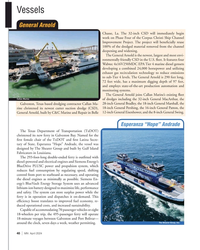 )
April 2024 - Marine News page: 40
)
April 2024 - Marine News page: 40? rst female chair of the TxDOT and ? rst Latina Secre- tary of State, Esperanza “Hope” Andrade, the vessel was designed by The Shearer Group and built by Gulf Island Fabricators in Louisiana. The 293-foot-long double-ended ferry is out? tted with diesel-powered and electrical engines and Siemens Energy’s
-
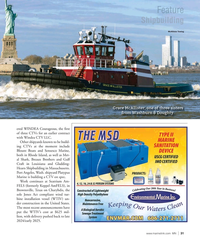 )
April 2024 - Marine News page: 31
)
April 2024 - Marine News page: 31known to be build- ing CTVs at the moment include Blount Boats and Sensesco Marine, both in Rhode Island, as well as Met- al Shark, Breaux Brothers and Gulf Craft in Louisiana and Gladding- Hearn Shipbuilding in Massachusetts. Port Angeles, Wash. shipyard Platypus Marine is building a CTV on spec. Work
-
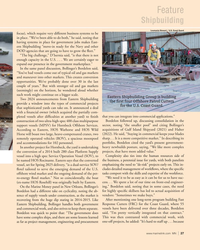 )
April 2024 - Marine News page: 27
)
April 2024 - Marine News page: 27for Hornbeck Offshore Services. sector, noting “the smaller pool” and citing Bollinger’s According to Eastern, HOS Warhorse and HOS Wild acquisitions of Gulf Island Shipyard (2021) and Halter Horse will boast two large, heave-compensated cranes, two (2022). He said, “Staying in commercial keeps your blades
-
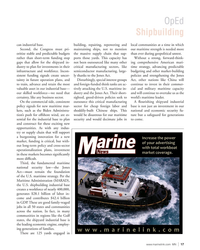 )
April 2024 - Marine News page: 17
)
April 2024 - Marine News page: 17.4 billion in GDP. These are good family-waged jobs in all 50 states and communities across the nation. In fact, in many communities in regions like the Gulf states, the shipyard industrial base is the leading economic engine, employ- ing generations of families. There are 125 yards engaged in www.marinelink
-
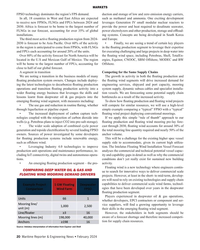 )
February 2024 - Maritime Reporter and Engineering News page: 20
)
February 2024 - Maritime Reporter and Engineering News page: 20Over 80% of the activity forecast for North America will be the ? oating wind space, including Petrobras, Shell, TotalEn- located in the U.S and Mexican Gulf of Mexico. The region ergies, Equinor, CNOOC, SBM Offshore, MODEC and BW will be home to the largest number of FPUs, accounting for Offshore. close
-
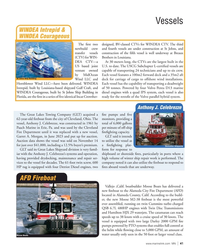 )
February 2024 - Marine News page: 41
)
February 2024 - Marine News page: 41. Hornblower Wind LLC—have been delivered. WINDEA Each vessel has the capability of transporting a deadweight Intrepid, built by Louisiana-based shipyard Gulf Craft, and of 50 tonnes. Powered by four Volvo Penta D13 marine WINDEA Courageous, built by St Johns Ship Building in diesel engines with a quad
-
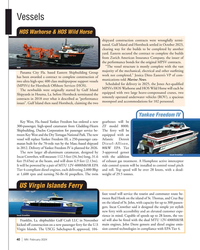 )
February 2024 - Marine News page: 40
)
February 2024 - Marine News page: 40Vessels HOS Warhorse & HOS Wild Horse shipyard construction contracts were wrongfully termi- nated. Gulf Island and Hornbeck settled in October 2023, clearing way for the builds to be completed by another yard. Eastern secured the contract to complete the builds from Zurich American Insurance Company
-
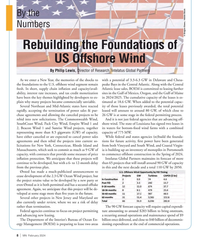 )
February 2024 - Marine News page: 8
)
February 2024 - Marine News page: 8and capacity/avail- Atlantic lease sales, BOEM is committed to leasing further ability, interest rate increases, and tax credit monetization sites in the Gulf of Mexico, Oregon, and the Gulf of Maine have been the key themes highlighted by developers to ex- in 2024/2025. The cumulative capacity of the leases
-
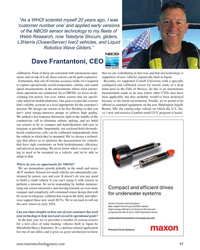 )
January 2024 - Marine Technology Reporter page: 49
)
January 2024 - Marine Technology Reporter page: 49, and sound con? gured and calibrated sensor for remote study of a deep speed measurements in the environments where most autono- brine pool in the Gulf of Mexico. So this is an autonomous mous operations are conducted. So at NBOSI, we focus on de- measurement made in an area where other CTDs may have
-
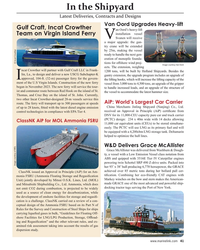 )
January 2024 - Maritime Reporter and Engineering News page: 41
)
January 2024 - Maritime Reporter and Engineering News page: 41In the Shipyard Latest Deliveries, Contracts and Designs Van Oord Upgrades Heavy-lift Gulf Craft, Incat Crowther an Oord’s heavy-lift installation vessel Team on Virgin Island Ferry VSvanen will receive a major upgrade: the gan- try crane will be extended by 25m, making the vessel ready to handle the
-
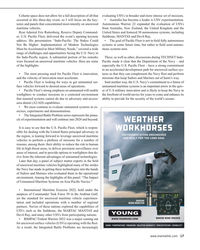 )
January 2024 - Maritime Reporter and Engineering News page: 17
)
January 2024 - Maritime Reporter and Engineering News page: 17Maritime Systems on Asia-Paci? c Navies:” • International Maritime Exercise 2022, held under the auspices of Commander Task Force 59 in the Arabian Gulf, set the standard for uncrewed maritime vehicle experimen- tation and included operations with a number of regional partners. Navies of these nations
-
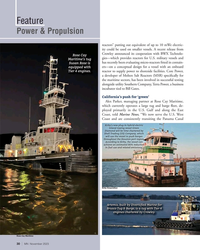 )
November 2023 - Marine News page: 30
)
November 2023 - Marine News page: 30for ‘green’ Alex Parker, managing partner at Rose Cay Maritime, which currently operates a large tug and barge ? eet, de- ployed primarily in the U.S. Gulf and along the East Coast, told Marine News, “We now serve the U.S. West Coast and are consistently transiting the Panama Canal Kirby’s new plug-in
-
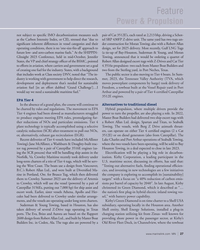 )
November 2023 - Marine News page: 27
)
November 2023 - Marine News page: 27Moran Towing; also with a Robert Allan operating conditions, there is no ‘one-size-? ts-all’ approach to design, set for 2025 delivery. Most recently, Gulf LNG Tugs future low- and zero-carbon marine fuels.” At the SHIPPIN- (a tie-up of Bay-Houston, Suderman & Young, and Moran GInsight 2023 Conference
-
 )
November 2023 - Maritime Reporter and Engineering News page: 80
)
November 2023 - Maritime Reporter and Engineering News page: 80. . . . . . . . . . . . . . . . . . . . . . . .www.greenseaiq.com/everclean . . . . . . . . . . . . . . . . . . . . . . . .Please visit us online 49 . . . . .Gulf Copper MFG CORP . . . . . . . . . . . . . . . . . . . . . . . . . . . . .www.gulfcopper.com . . . . . . . . . . . . . . . . . . . . . . . . . . .
-
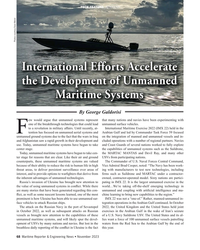 )
November 2023 - Maritime Reporter and Engineering News page: 68
)
November 2023 - Maritime Reporter and Engineering News page: 68affairs. Until recently, at- International Maritime Exercise 2022 (IMX 22) held in the Ftention has focused on unmanned aerial systems and Arabian Gulf and led by Commander Task Force 59 focused unmanned ground systems due to the fact that the wars in Iraq on the integration of manned and unmanned
-
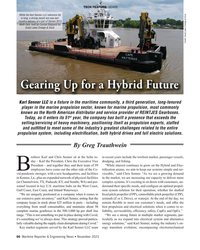 )
November 2023 - Maritime Reporter and Engineering News page: 66
)
November 2023 - Maritime Reporter and Engineering News page: 66sit down with customers, un- sonnel located in key U.S. maritime hubs on the West Coast, derstand their speci? c needs, and con? gure an optimal propul- Gulf Coast, East Coast, and Inland Waterways. sion system solution for their operation, whether for shafted “We are uniquely positioned as a company when
-
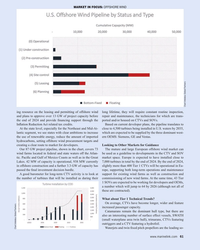 )
November 2023 - Maritime Reporter and Engineering News page: 61
)
November 2023 - Maritime Reporter and Engineering News page: 61wind market can wind farms located in federal and state waters off the Atlan- be used as a guideline to developments in the CTV and SOV tic. Paci? c and Gulf of Mexico Coasts as well as in the Great market space. Europe is expected to have installed close to Lakes. 42 MW of capacity is operational, 938
-
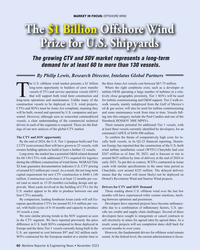 )
November 2023 - Maritime Reporter and Engineering News page: 60
)
November 2023 - Maritime Reporter and Engineering News page: 60turbine commissioning and O&M support. Tier 2 walk-to- construction vessels to be deployed on U.S. wind projects, walk vessels, mainly redeployed from the Gulf of Mexico’s CTVs and SOVs must be Jones Act compliant, meaning they oil & gas sector, will also be used for turbine commissioning will be built,
-
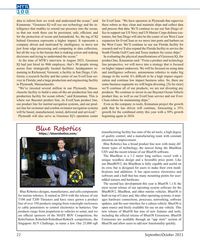 )
September 2023 - Marine Technology Reporter page: 22
)
September 2023 - Marine Technology Reporter page: 22, research and we’ll also expand the Florida facility to service the but all the way to the human that is making action and making South Florida Gulf Coast and Texas markets for cruise ships.” decisions and trying to understand the ocean.” In evaluating the physical manifestations of Greensea IQ,
-
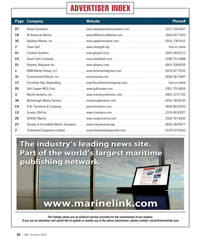 )
October 2023 - Marine News page: 48
)
October 2023 - Marine News page: 48(337) 330-4407 19 All American Marine www.AllAmericanMarine.com (360) 647-7602 35 Appleton Marine, Inc www.appletonmarine.com (920) 738-5432 7 Clean Gulf www.cleangulf.org Visit us online 41 Creative Systems www.ghsport.com (360) 385-6212 C2 David Clark Company www.davidclark.com (508) 751-5888 21
-
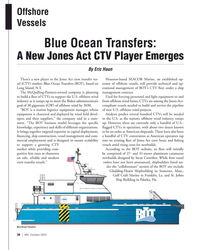 )
October 2023 - Marine News page: 36
)
October 2023 - Marine News page: 36have not been announced, shipbuilders listed un- der the “collaborators” section of the BOT site include Gladding-Hearn Shipbuilding in Somerset, Mass., Gulf Craft Marine in Franklin, La. and St. Johns Ship Building in Palatka, Fla. Blue Ocean Transfers 36 | MN October 202
